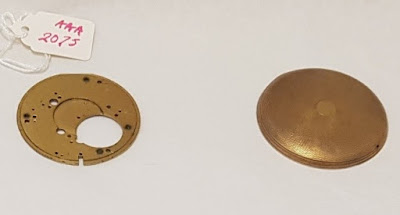While researching my master thesis, A Matter of Time – Franklins Pocket Watches in the Arctic, I came across James Reid's pocket watch's dust cover. From the letters of James Fitzjames we know, that the Erebus` Ice master James Reid was 'rough, intelligent, unpolished, with a broad North-Country accent, but not vulgar, good-humoured and honest-hearted'. And, as I would add, he certainly knew how to make a good impression and act like a gentleman. The dust cover from his pocket watch, now in the National Maritime Museum collection, made of gilt brass, had his name engraved in a cursive script. Most likely, the pocket watch case going with this dust cover was made of gold, adding to the object's material value.
Two pocket watch fragments in the National Maritime Museum`s collection fit not only in material, but also in size to the dust cover. A plate from the interior of a watch, AAA 2075, made of gilt brass, and a golden pocket watch case, AAA2076, may have belonged to James Reid`s pocket watch. Golden cases were not the most practical ones for long expeditions. Being softer than silver, the cases had to been repaired regularly. So, James Reid must have had an additional motive to possess this watch. Maybe it was a gift from a beloved person or ship comrade; maybe he just liked to show his success as a whaling captain. After all, with the ever-increasing demand for whalebone, used for corsets in the latest fashion, whaling was extremely profitable. Whatever reason he may have had, it was more than just a tool to know what time it is.
While the ships had ten chronometers
each, set on the Greenwich time, there were probably the same amount of
privately owned pocket watches. Not as accurate as the chronometers, the pocket
watches could also work as navigational tools if necessary. By comparing the
local time with the Greenwich time, the officers could estimate their position.
In the Arctic climate, where the horizon may be not visible due to fog and the
sun, moon and stars may be difficult to see during certain seasons, the
chronometer or the pocket watches became increasingly important. In the lack of
knowledge of the Arctic with the ships frozen in the ice, the men set out for a
tiring and in the end deadly journey overland. It is on this journey that the
pocket watches became an invaluable tool for navigation.
In 2016, researchers made a facial reconstruction based on bone fragments found at Erebus Bay. Comparing them to
the two sets of 14 daguerreotypes of the officers, James Reid became a probable
candidate for these bones. The researches themselves pointed out that this
facial reconstruction must be interpreted carefully. Of 135 men, they had 14
daguerreotypes to compare the face with. This being said, I would like to
explore what story the dust cover James Reid's may tell us about the journey.
If James Reid did die on Erebus Bay,
why was his watch found by a group of Netsilingmiut close to the northwest of
the Back River's mouth, around 150 km linear distance? And was it another
officer? From the number of pocket watches at this campsite, William Henry
Gilder, an American journalist who went with Lieutenant Schwatka in his search
for Franklin, certainly thought so. As he writes himself on page 9 of the introduction, this hypothesis has
been criticised by no other than Vice-admiral Sir George Richards.
"Watches and silver relics," writes Vice-admiral Sir George Richards,
"do not necessarily indicate a corresponding number of officers. Such
light valuable articles would naturally be taken by the survivors."
Maybe James Reid gave his pocket watch to one of his comrades, trying to ensure his survival by giving him a tool to navigate through unknown regions. Maybe a friend took it with him to bring it back to his family. We will never know. But if the dead men at Erebus bay will be identified as James Reid, his dust cover will be more than a symbol for a tragic end; it stands for hope, comradery and love.


Comments
Post a Comment